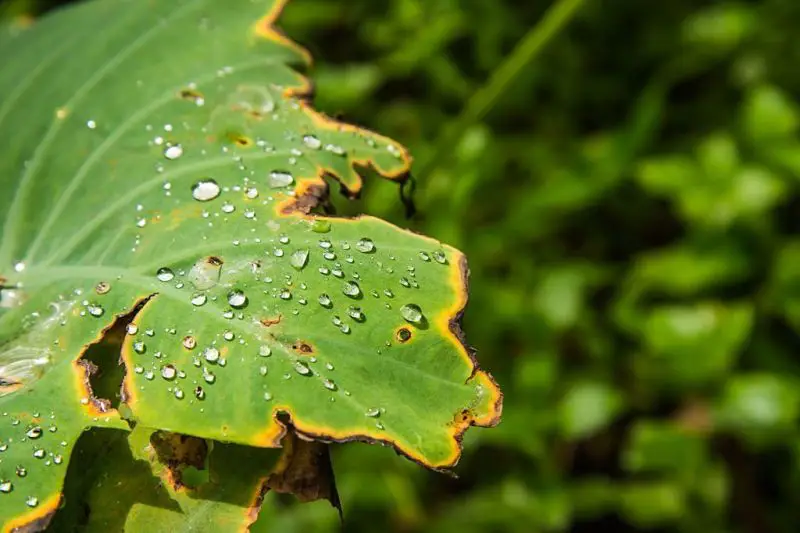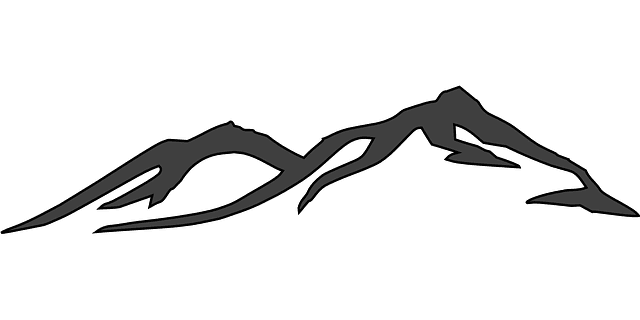Holes in alocasia leaves are usually caused by pests such as slugs, snails and mites that are feeding on the plant’s leaves.
Alocasia, also known as taro plant or elephant ears, is a beautiful houseplant that can be grown outdoors in tropical and subtropical climates.
The leaves of this plant are large and glossy, with many different shapes and colors. If you notice holes in the leaves of your Alocasia, don’t worry! It’s not uncommon for insects to damage the leaves of this plant.
Here are some common insect pests that can cause holes in Alocasia leaves:
Spider Mites
Alocasia plants are susceptible to spider mites, which are tiny arachnids that live on the undersides of leaves. These tiny creatures are usually not visible to the naked eye, but they can cause major damage to your plant if left untreated.
Spider mites can be identified by their silvery appearance and red or orange coloration. They often leave small pinprick holes in your alocasia leaves. If you see these signs, you should immediately isolate your plant from other plants in your home so that it does not spread to them as well.
Spider mites thrive in warm temperatures and dry conditions, so if you notice this problem occurring in your home during the summer months it may be due to increased heat and humidity levels. This is why treatment is so important!
Scale insects
Scale insects are small, immobile insects that feed on the sap of plants. They secrete a waxy substance called honeydew, which can be seen as a shiny, sticky substance on leaves and stems of affected plants.
Scale insects can affect many different types of plants including azaleas, hibiscus, ferns and camellias. These pests are often found on new growth of the plant in spring and summer months. Some scale insects are more damaging than others; however all scale insect infestations can cause damage to the plant if left untreated.
The best way to control scale insects is by applying an insecticidal soap to affected areas every three weeks during warm weather months. If you have an infestation, it’s important to apply the insecticide when temperatures are between 55-80 degrees Fahrenheit to ensure that it works properly and doesn’t damage your plant more than necessary.
In addition to treating individual areas with insecticides, it’s important to make sure that your entire garden has been treated before planting anything new or bringing any new plants into your home or business premises as this will help prevent future problems from occurring again in future years.
Thrips
Thrips are small insects that feed on plant sap, and they can cause serious damage to your Alocasia leaves.
Thrips can be difficult to identify because they are so small and because they may fly away when you disturb the leaves. However, if you notice that a leaf of your Alocasia plant has brown spots or lesions on it, then it is likely that there are thrips in your plant. The spots or lesions caused by thrips will be very small and circular in shape, with a pale ring around them.
If you notice any signs of an infestation in your Alocasia plants, you should remove affected leaves as soon as possible. You can then treat the affected areas with insecticidal soap or neem oil.
Mealy bug
The mealy bug is a tiny little creature that can do some major damage to your plant. Mealy bugs love to feed on the sap of plants and they leave behind a sticky residue called honeydew. This honeydew attracts ants and other insects that feed off it, which can cause problems for your plant’s root system.
You can find mealy bugs on any part of the plant the stems, leaves, or roots and they are typically grayish white in color with a waxy coating that makes them look like they’re covered in flour. The easiest way to get rid of them is to use an insecticidal soap or oil spray, but you may need to reapply every few days until there are no more signs of them present.
Aphids
Aphids are small, winged insects that suck plant sap and feed on the leaves of some plants, including alocasia. The aphids produce honeydew, a sticky substance that falls to the ground and attracts ants and other insects. The ants protect the aphids from predators and provide them with food in return for the honeydew.
Aphids cause leaves to develop holes when they puncture the undersides of the leaves with their mouthparts. These wounds allow air to penetrate into the plant’s tissues, which can lead to infection if not treated promptly.
In addition to causing damage directly, aphids also transmit viruses that cause leaf spots or cankers on alocasia plants. These viruses are transmitted from one plant to another by aphids that feed on an infected plant and then move onto a healthy one.
Whiteflies
Whiteflies are tiny, white insects that are attracted to the color white. They suck the juices from the undersides of leaves and cause holes in Alocasia leaves. In order to prevent this from happening, you can place a thin layer of diatomaceous earth around the top of your Alocasia plant, which will keep whiteflies away.
If you notice that there are holes in any of your Alocasia leaves, this is usually caused by a fungus called powdery mildew. You can get rid of this by spraying your plant with milk and water every two days for three weeks straight.
Slugs & Snails
Alocasia leaves are susceptible to damage by slugs and snails. These pests can cause holes in the leaves of the plant that will not heal, leading to a loss of leaf area.
If your alocasia plant has small holes in its leaves, it’s likely that slugs or snails have been eating them. Slugs and snails feed on living plants as well as dead ones, so if you notice a lot of shallow holes in your alocasia’s leaves or any other parts of the plant, there is a good chance that slugs or snails are responsible for it.
Holes in Alocasia leaves due to disease
Alocasia leaves can develop holes due to a number of different plant diseases.
The most common cause is crown rot, stem rot,root rot, leaf spot.
Crown rot
Crown rot is caused by bacterial infection that starts at the base of the plant and works its way up. It’s mainly a problem in poorly-drained soil, and it can be treated with fungicide.
Stem rot
Stem rot is another bacterial infection that causes the plant’s stem to become mushy, brownish-green, and soft. This type of rot can also be treated with fungicide.
Root rot
Root rot is caused by fungal infection that affects the roots of your Alocasia plants. It usually shows up in newly planted Alocasia plants as yellowing leaves or brown spots on the undersides of their leaves.
Leaf Spot
Alocasia leaves can get leaf spot, which is a fungal disease. The symptoms of alocasia leaf spot on the leaves are usually circular or irregularly shaped spots that are brown or black in color. The spots can also have yellow to white centers.
These spots are the result of spores from fungus which causes leaf spot. The fungus is spread by splashing water or raindrops onto the leaves, leaving them wet for a long period of time and then allowing them to dry out in the sun.
You can treat alocasia leaf spot by spraying your plant with neem oil or baking soda, both of which are natural fungicides that will kill off the spores and prevent further spread of this disease.
How do I get rid of the holes in my Alocasia leaves?
You can get rid of these pesky insects by spraying your Alocasia with a pesticide that contains neem oil or pyrethrin. You should also prune away any damaged leaves and stems that may be harboring scales. The best way to prevent them from coming back is by keeping your plant healthy and well-watered, so it has plenty of nutrients to fight off pest infestations.
Are the holes in my alocasia leaves a problem?
No, they’re not. Alocasia leaves are very durable, and the holes in them are a natural part of their lifecycle. The best thing you can do is water your plants regularly and not worry about those little holes!
Conclusion
Hope you enjoyed this blog post on why there are holes in Alocasia leaves and how to solve them. If you have any questions or comments, feel free to leave them below!
Thanks for reading 🙂
Also Read: Holes in Green Bean Leaves: What’s Causing Them, & What To Do About It
